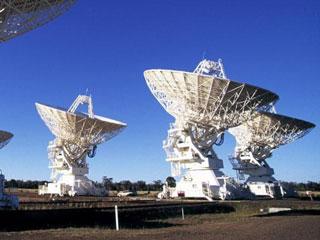
Astronomers using the Commonwealth Scientific and Industrial Research Organisation's Compact Array telescope (in picture) have detected the raw material for making the first stars in galaxies that formed when the Universe was just three billion years old. Photo: CSIRO.
MELBOURNE (PTI): Astronomers have detected the raw material for making the first stars in galaxies that formed when the universe was just three billion years old - less than a quarter of its current age.
The finding by The Commonwealth Scientific and Industrial Research Organisation's Australia Telescope Compact Array telescope near Narrabri, New South Wales, opens the way to studying how these early galaxies make their first stars.
"It one of very few telescopes in the world that can do such difficult work, because it is both extremely sensitive and can receive radio waves of the right wavelengths," said CSIRO astronomer Professor Ron Ekers.
The raw material for making stars is cold molecular hydrogen gas, H2. It can't be detected directly but its presence is revealed by a 'tracer' gas, carbon monoxide (CO), which emits radio waves.
In one project, astronomer Bjorn Emonts (CSIRO Astronomy and Space Science) and his colleagues used the Compact Array to study a massive, distant conglomerate of star-forming 'clumps' or 'proto-galaxies' that are in the process of coming together as a single massive galaxy.
This structure, called the Spiderweb, lies more than 10 billion light years away.
Dr. Emonts' team found that the Spiderweb contains at least 60 billion times the mass of the sun in molecular hydrogen gas, spread over a distance of almost a quarter of a million light years.
This must be the fuel for the star-formation that has been seen across the Spiderweb. "Indeed, it is enough to keep stars forming for at least another 40 million years," said Dr. Emonts.
In a second set of studies, Manuel Aravena (European Southern Observatory) and colleagues measured CO, and therefore H2, in two very distant galaxies.
The faint radio waves from these galaxies were amplified by the gravitational fields of other galaxies - ones that lie between us and the distant galaxies.
This process, called gravitational lensing, "acts like a magnifying lens and allows us to see even more distant objects than the Spiderweb," said Dr. Aravena.
Dr. Aravena's team was able to measure the amount of H2 in both galaxies they studied. For one (called SPT-S 053816-5030.8), they could also use the radio emission to make an estimate of how rapidly the galaxy is forming stars - an estimate independent of the other ways astronomers measure this rate.
 Previous Article
Previous Article













The Indian Air Force, in its flight trials evaluation report submitted before the Defence Ministry l..
view articleAn insight into the Medium Multi-Role Combat Aircraft competition...
view articleSky enthusiasts can now spot the International Space Station (ISS) commanded by Indian-American astr..
view article